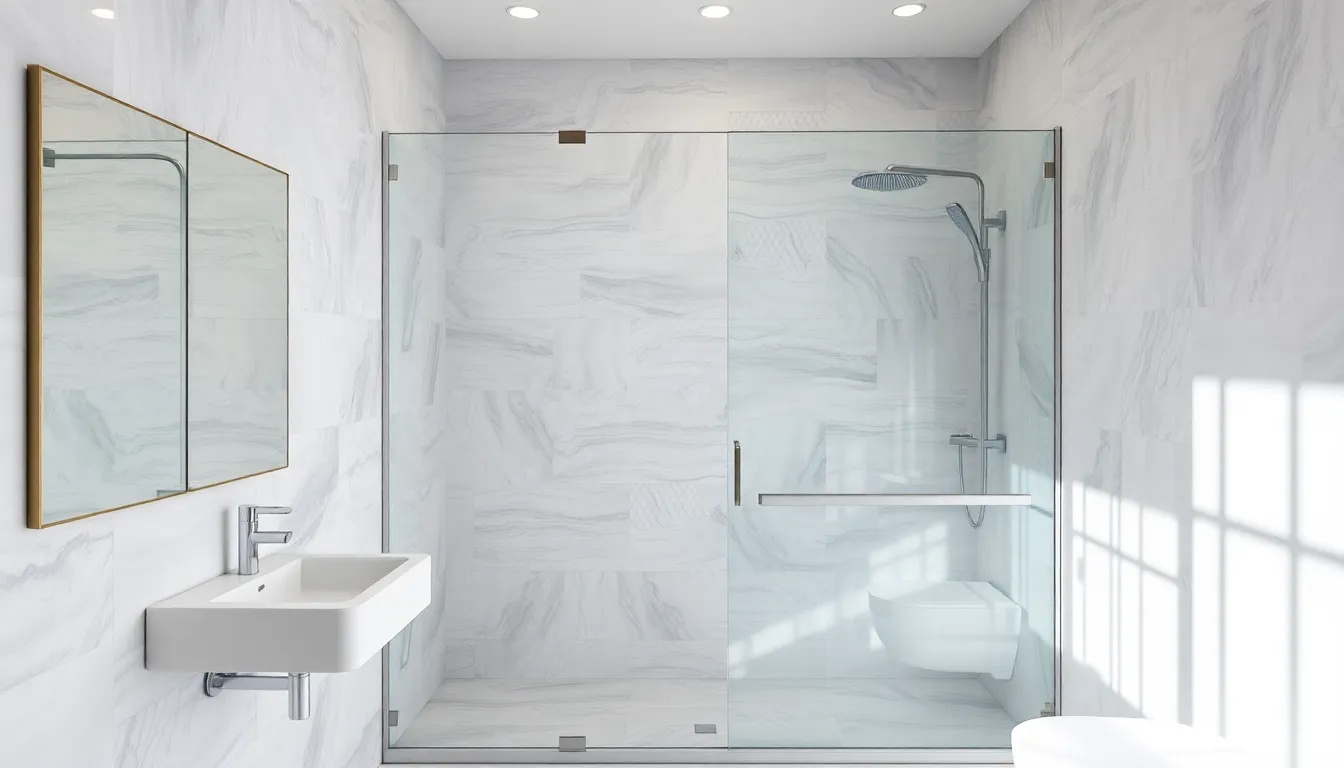Transforming a bathroom can be as simple as upgrading the shower door. A sleek, modern shower door not only enhances the aesthetic appeal but also increases the functionality of the space. With various styles and materials available, choosing the right door can elevate any bathroom design.
Installing a shower door may seem daunting, but with the right guidance, it can be a rewarding DIY project. Understanding the installation process helps ensure a secure fit and prevents future issues. From measuring the space to selecting the perfect hardware, every step matters in achieving a polished look. Whether it’s a framed, frameless, or bi-fold door, getting it right can make all the difference.
Table of Contents
ToggleOverview of Shower Door Installation
Shower door installation involves several critical steps that ensure proper fit and functionality. Understanding these steps simplifies the process and enhances the final result.
- Measuring the Space: Accurate measurements are essential. First, measure the width and height of the shower opening. Consider the type of door to determine specific dimensions. This ensures the selected door fits seamlessly.
- Choosing the Right Style: Various styles are available, including framed, frameless, or bi-fold. Each style offers different aesthetics and functionality. For instance, framed doors provide added support while frameless options create a more open feel.
- Selecting Hardware: Hardware selection affects both the stability and appearance of the shower door. Choose hinges, handles, and tracks that match the door style and bathroom decor. Quality hardware ensures durability and ease of use.
- Preparing the Area: Before installation, clear the shower area and ensure the surface is clean and dry. This prevents potential issues during installation and guarantees an accurate placement of the door.
- Installation Process: Follow the manufacturer’s instructions carefully. Start by installing the tracks or hinges. Next, position the door and secure it in place. Adjustments may be necessary for a perfect fit.
- Sealing and Finishing Touches: Proper sealing prevents water leaks and enhances longevity. Use silicone caulk along the edges where the door meets the wall and shower base. Allow adequate time for drying before using the shower.
By following these steps, he or she can achieve a successful shower door installation that significantly elevates the bathroom’s aesthetic appeal and practicality.
Benefits of Shower Door Installation

Shower door installation offers numerous advantages, enhancing both the appearance and usability of a bathroom space.
Increased Aesthetics
Installing a shower door enhances the bathroom’s overall aesthetic appeal by providing a sleek, modern look. Frameless shower doors, for example, create an illusion of more space and light, contributing to an open feel. The variety in styles, such as framed or bi-fold options, allows homeowners to choose a design that complements their decor. Clear glass doors showcase beautiful tiles or decorative elements, elevating the visual impact of the entire bathroom.
Improved Functionality
Shower doors significantly improve functionality by preventing water spills, reducing the risk of slips and falls in other areas of the bathroom. They provide a dedicated wet area, making it easier to maintain a clean and organized environment. The right shower door also stabilizes the temperature within the shower, offering a comfortable experience. Additionally, modern hardware options facilitate smooth operation, ensuring durability and longevity for regular use.
Types of Shower Doors
Shower doors come in various styles, each offering unique features and benefits. Understanding these types helps homeowners select the most suitable door for their bathroom.
Hinged Shower Doors
Hinged shower doors, also known as pivot doors, attach to the wall via hinges. They swing outward or inward, creating an elegant and traditional look. Key characteristics of hinged shower doors include:
- Versatile Installation: These doors fit various spaces, accommodating small to large showers effectively.
- Glass Thickness: Typically, they feature glass thickness ranging from 3/8 inch to 1/2 inch for durability and stability.
- Design Options: They offer customization through various finishes and hardware, allowing them to match any bathroom decor.
These features ensure hinged shower doors provide a sophisticated touch while allowing easy access to the shower area.
Sliding Shower Doors
Sliding shower doors consist of two or more panels that slide along a track, making them ideal for limited space. Prominent features of sliding shower doors include:
- Space Efficiency: Sliding doors do not require additional room for swinging open, making them fitting for compact bathrooms.
- Wide Accessibility: These doors provide a large entryway, enhancing convenience for users.
- Choice of Materials: Many styles feature framed or frameless designs, ensuring integration with various bathroom aesthetics.
The practical design of sliding shower doors maximizes space while delivering a modern and sleek appearance.
Bi-Fold Shower Doors
Bi-fold shower doors fold inwards, similar to accordion-style doors, making them suitable for tight areas. Notable aspects of bi-fold shower doors include:
- Compact Design: They minimize the space needed for operation, perfect for small bathrooms or shower enclosures.
- Ease of Use: Bi-fold doors are easy to open and close, facilitating hassle-free access to the shower.
- Aesthetic Appeal: These doors can enhance a bathroom’s aesthetics with various glass options and finishes available.
Bi-fold shower doors provide functionality and style, making them an excellent choice for maximizing space in smaller areas.
Essential Tools and Materials
For a successful shower door installation, having the right tools and materials is crucial. Proper preparation ensures efficiency and quality in the installation process.
Tools Required
- Measuring Tape: Measuring tape provides accurate dimensions for the door and enclosure.
- Level: A level ensures the door is perfectly vertical and horizontal for proper function.
- Drill: A power drill helps create holes for mounting hardware, providing secure attachment.
- Screwdriver: A screwdriver is necessary for fastening screws on the hinges and hardware.
- Caulk Gun: A caulk gun applies silicone sealant around the edges for a watertight fit.
- Rubber Mallet: A rubber mallet assists in adjusting door panels without damaging the glass.
- Safety Glasses: Safety glasses protect eyes during installation tasks involving glass handling.
- Utility Knife: A utility knife easily cuts through any caulking or weather stripping that may interfere with installation.
Materials Needed
- Shower Door Kit: A complete shower door kit includes the door panels, hinges, handles, and any required hardware.
- Silicone Sealant: Silicone sealant prevents water leaks by creating a waterproof barrier around the door.
- Mounting Hardware: Mounting hardware includes screws and brackets necessary to secure the door to the wall.
- Floor Guide: A floor guide stabilizes the movement of sliding shower doors, ensuring smooth operation.
- Weather Stripping: Weather stripping provides additional insulation and a watertight seal around edges.
- Towel or Cloth: A towel or cloth is useful for cleaning surfaces before installation and for handling materials safely.
By gathering these essential tools and materials, individuals can streamline their shower door installation project, ensuring a professional finish and lasting results.
Steps for Shower Door Installation
This section outlines the essential steps for a smooth shower door installation process. Proper preparation and attention to detail ensure a successful outcome.
Preparing the Space
Preparing the space for installation starts with thoroughly cleaning the shower area. Remove any existing fixtures, ensuring a clear work surface. Measure the width and height of the shower opening with a measuring tape, noting any irregularities. Mark the desired position of the door and frame with a level, ensuring it’s straight. Inspect the walls and floor for stability; repair any damage that could affect installation. Collect the necessary tools and materials to streamline the installation process.
Installing the Frame
Installing the frame involves carefully assembling it before securing it to the wall. Position the frame in the marked location, checking its level with a level tool. Use a drill to attach the frame to the wall, ensuring the screws penetrate deeply for stability. If applicable, install the bottom track, aligning it properly with the marks made earlier. Apply silicone sealant along the edges of the frame to prevent water leakage. Allow the sealant to cure as per manufacturer instructions before proceeding.
Hanging the Door
Hanging the door requires caution and precision to achieve proper function. First, attach the hinges or rollers to the door, following the manufacturer’s specifications. Once the hardware is in place, lift the door into position against the frame. Secure the door’s hinges or rollers to the installed frame, ensuring the door swings or slides smoothly. Adjust the door, if needed, for even gaps on all sides. Finally, apply silicone sealant along the edges and joints to create a watertight seal that enhances durability.
Upgrading a shower door can significantly enhance a bathroom’s look and functionality. With the right tools and a bit of patience anyone can tackle this DIY project successfully. Understanding the various styles and installation steps ensures a seamless process that leads to impressive results.
The choice of materials and attention to detail during installation play a crucial role in achieving a durable and aesthetically pleasing finish. By investing time in preparation and following the outlined steps anyone can transform their shower space into a modern oasis that combines beauty and practicality. A well-installed shower door not only elevates the bathroom’s design but also enhances the overall experience of daily routines.


